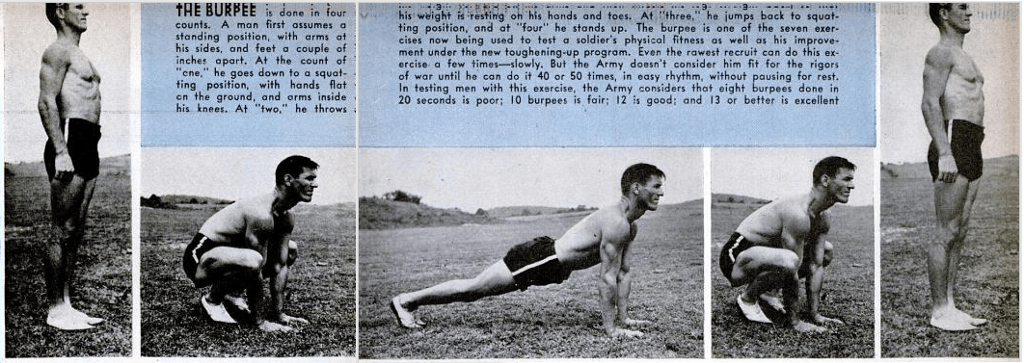If you were involved in military training or any kind of athletics, chances are you were punished by being ordered to drop into a squat, kick your feet back into a push-up plank, jump back into a squat and then stand up again. Whatever they were called — up-downs, front leans, jumping push-ups, squat thrusts or some made-up name devised by one of my idiot coaches — I didn’t like doing them and wanted to be finished with them as soon as possible. I certainly had no idea that I’d be doing them again in 2009 at a CrossFit affiliate at the University of Pittsburgh, participating in the so-called “sport of fitness,” or that by 2018, seemingly everybody in the country would have at least a passing familiarity with what are now best known as burpees.
“It’s a testament to the overall net gain in knowledge we’ve seen since the launch of CrossFit that the burpee is as well known as it is,” says Andy Galpin, a professor at the Center for Sport Performance at California State University, Fullerton. “But this is an old exercise, a very basic bodyweight movement that was surely used to some extent thousands of years ago by people engaged in martial or physical training.”

Credit for the now-common name of the exercise goes to Royal Burpee, who, while enrolled as a PhD candidate in physiology at Columbia University back in 1939, codified the movement into four separate “counts” or steps (a progression that’s since evolved to five or six steps, depending on the coach). Burpee apparently didn’t see this as something that should be done in high volume — as when CrossFitter Mikko Salo bangs out 1,000 to prove a point — but rather a movement that could be done in spurts to warm up the body.
According to an interview with Burpee’s granddaughter Sheryl Dluginski that appeared in The Huffington Post, the physiologist had intended the burpee to serve as an exercise that could be used to quickly elevate a trainee’s heart rate after baseline resting measurements had been taken, providing a good picture of general cardiovascular fitness. It became a part of a general U.S. military fitness test in 1942, during which trainees attempted to complete as many burpees as possible in under a minute. Forty-one was considered excellent and is still quite good if you adhere to the somewhat lax burpee standards — you’re not going chest-to-deck, as with today’s CrossFit Games burpees — of the wartime era, while 15 would place you at the bottom of the heap.
None of this history, however, explains why so many people now know what a burpee is, even if they’re performing them far from perfectly. As Galpin noted, CrossFit programming raised awareness of the burpee starting in the 2000s, but the appearance of burpees in CrossFit programming is itself a bit of a mystery. CrossFit founder Greg Glassman and CrossFit Games Director Dave Castro surely had a hand in including the exercise, but the company’s longtime Olympic weightlifting coach Mike Burgener performed burpees while in the U.S. Marine Corps and always incorporated them in training seminars he conducted in the 1980s and 1990s.
“The burpee — that’s a strange word, I suppose, but I always called them burpees and I’ve always done them myself,” Burgener says. “They were a part of my sports training and then a part of my Marine Corps training back in the 1960s. I’d utilize them in weightlifting courses I was teaching as a way of keeping trainees involved and motivated. I’ve always used them as a warm-up exercise, and I have still have my trainees doing a very basic version of them.”
When I mention to Burgener that Galpin suggested he might’ve played a role in bringing the burpee to CrossFit programming, and thus to the wider world, he shrugs. “Glassman and Castro, who was a SEAL, were obviously aware of and using the exercise, but so was I, so it’s interesting to see how it’s evolved,” he says. “The big story here is how the fitness world has evolved and how knowledge has spread. You see things happening regularly that were unheard-of before, like women doing pull-ups. The pull-up was an exercise that wasn’t in common usage either, and CrossFit helped popularize that, too.”
With the burpee serving as a central component of CrossFit programming and the CrossFit Games, numerous variants have evolved: burpee box jumps, burpee pull-ups, burpees with lateral jumps over a barbell, burpees paired with lap swimming, and so on and so on and so on.
In spite of the many programming possibilities it presents, Galpin views the burpee as far from the perfect single exercise. “The deadlift is a much better exercise, for example, because it’s intense, relatively easy to perform, and highly scalable, since trainees can add weight to the bar as they progress,” he says. “The burpee, by contrast, is something that’s great for getting a person who is out of condition into better condition and great for a fast workout in a hotel room, but it doesn’t scale the way the deadlift does. You can add a weight vest, perhaps, but if you’re at a point where you’re doing 1,000 of them, as some trainees can eventually do, they’re not providing the most bang for your buck in terms of exercise efficiency.”
When I returned to burpees in 2009 — never having known their proper name but performing them grudgingly nonetheless — it was because I’d bought into the then-dominant message that CrossFit was a sport, fancying this as a triumphant return to the world of athletics. Instead of takedowns or reversals, I was concerned with completing “chest to deck” burpees and other movements per ever-evolving “Games standards” in order to… be the best at exercising, I guess. And I suppose was actually good at stringing together lots of burpees even as I lagged in many other areas. In the process, I developed a bunch of nagging shoulder injuries and even a movement as simple as the burpee began to feel like torture, so I eventually abandoned CrossFit in much the same way as I’ve abandoned so many other passing enthusiasms.
“To its credit, CrossFit has gotten much better at separating the Games performances from its exercise programming, meaning the professional athletes are training in a high-intensity and specialized manner with a much higher injury threshold than regular folks,” says Galpin after I’ve related that anecdote. “And like I said, CrossFit has been a positive force in terms of disseminating knowledge about exercise and fitness. If people are exploring exercises like burpees, that’s a great start. That’s a major improvement from where we were 30 years ago.”
Long-time fitness journalist Anthony Roberts has a slightly different perspective on this shift. “Back in the 1980s and 1990s, you wouldn’t know all this stuff unless you were ‘into’ fitness, but if you weren’t, it was rare that someone would bludgeon you with minutiae from that world,” he says. “Now even a tenuous social media proxy friendship will expose you to posts such as ‘just finished the #deathbyburpees wod’ and ‘awesome MetCon today at #CrossFit’.” The burpee, per Roberts’ line of reasoning, isn’t just ubiquitous; it’s inescapable.
I asked Coach Burgener if he ever once considered, during his prior career as a USMC officer, that the burpee would somehow transcend military physical training to become a universally known exercise as well as a core component of a sport that’s now used to fill a massive amount of late-night airtime on the CBS Sports Network. “Oh, absolutely not,” he says. “I’ve stuck with CrossFit since the outset, but I had no idea where any of this was going. I coached some hellacious athletes in the 1980s, but nobody besides Olympic weightlifting insiders knew who they were. Now you can go on YouTube and get a crash course on the history of modern fitness in a couple minutes. The burpee becoming a part of the CrossFit games, or just the fact that we’re calling it the burpee instead of something else, like a squat thrust — man, who could have predicted it?”

